You Never Forget the Smell
Remembering one of North America’s last whaling stations.
Article body copy
Armed with hooked metal blades mounted on wooden poles, six men swarm around the body of the 50-tonne fin whale like worker ants. One man climbs atop the whale, putting him three meters above the concrete floor, and makes a deep slice along the length of its body. His coworkers peel back the skin and underlying blubber, exposing a 13-meter-long fillet of flesh.
Once stripped off the bone, the choice cuts of meat will be chopped into mailbox-sized chunks, flash-frozen, and eventually sold as mink food under the brand Moby Dick.
Everything in this film footage, including the men, is painted the same bloody shade of crimson.
In 1954, the year the scene was shot, 150 fin whales were killed for their oil and flesh in the waters off the northwest coast of Vancouver Island, British Columbia.
Blow the Wild Whale recounts the early days of whale hunting and processing at the whaling station in Coal Harbour, an isolated community about 350 kilometers northwest of Vancouver. Along with fin whales, the station also processed sperm, humpback, sei, and the occasional blue whale during the two decades it operated in the mid-20th century.
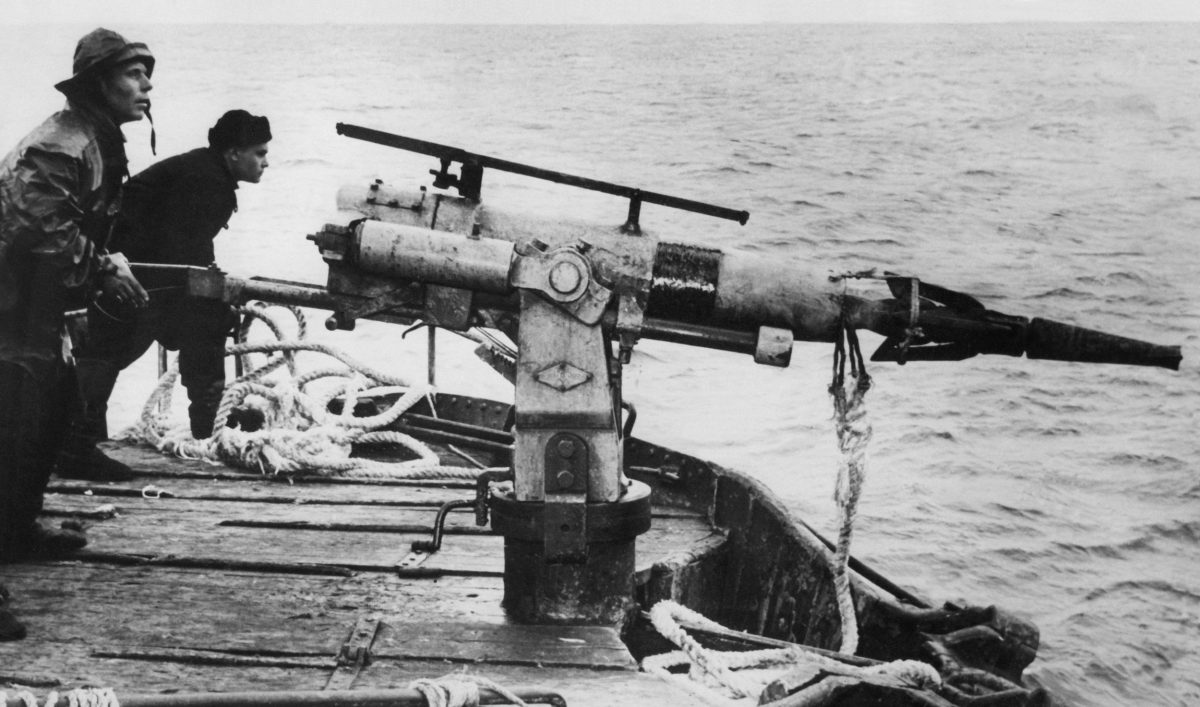
By the mid-20th century, commercial whalers, such as these Russian whalers, used grenade harpoons mounted on chaser boats to kill the large whales they pursued. Photo by Marka/Alamy Stock Photo
A particular blend of geography and history made Coal Harbour a hub for whaling. Whales regularly swam along Vancouver Island’s west coast on their migratory routes, and Quatsino Sound forms a 50-kilometer conduit between the open ocean and Coal Harbour, tucked into a tiny bay near the back of the sound. Gunners on chaser boats harpooned the whales, then tow boats hauled them up the sound to the village, where hangars, barracks, and a wharf left over from the Second World War provided the infrastructure required for such a venture.
Ships bound for Seattle and Vancouver regularly made the passage up the sound to call at the village, its harbor awash with putrid whale blood and oil during a hunting season lasting from April to late September. The tankers left with cargos of vitamin A oil, squeezed from whales’ livers; various grades of oil rendered from blubber, flesh, and viscera; and dried and frozen meal.
Harry Hole, now 84, remembers the regular visits of the big tankers as far back as 1951, the year he started at the whaling station as a summer student. More than six decades later, we meet at Coal Harbour’s museum—located in what was once the fresh meat processing plant—surrounded by relics and curios from the station’s heyday: rusty harpoons, whale meat labels, and sepia newspaper clippings chronicling the zeitgeist of whaling life.
The museum was created by Hole’s friend and local businessman Joel Eilertsen, and Hole volunteers at the museum, greeting any visitors that might wander in. On a good day in the summer there might be 20, slowing down to three or four in the off-season. But if Hole is there, the visitors are treated to a living history exhibit—as far as he knows, he is Coal Harbour’s last surviving commercial whaler.
“You never forget the smell,” says Hole, who likens the odor of a whaling station to a chicken rendering plant—only 30 times stronger.
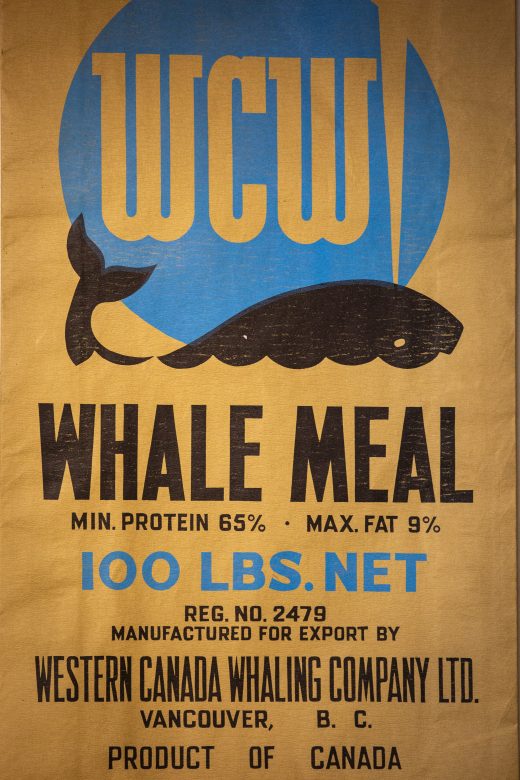
Whale meal for livestock and pet food was just one of the products derived from the whales brought into the Coal Harbour whaling station on Vancouver Island, British Columbia. Other commodities included various grades of oil, bone meal fertilizer, and meat for human consumption. Photo by Grant Callegari
He describes the experience of flensing, or skinning, a 25-meter blue whale, the biggest they ever brought in, as something akin to peeling a banana. “It didn’t bother me cutting up a whale. It wasn’t much different than cutting up a deer, except the body was much, much bigger.”
Hearing Hole’s stories over the course of several early summer afternoons, it’s tempting to dismiss him as a relic of a more abundant, less enlightened age. Commercial whaling ended in this corner of the northeast Pacific more than 50 years ago, and since then we have discovered a lot about the intelligence, language, and society of whales. Public opinion has overwhelmingly shifted against the commercial slaughter of whales as tradable commodities in a global marketplace.
But while Hole tours me through the museum, Japanese whalers are preparing to commercially hunt whales in the Pacific for the first time in over 30 years. They have finally dispensed with the ruse they were only whaling for scientific purposes and pulled out of the International Whaling Commission (IWC)—the international body formed to oversee the conservation and management of global whaling—which banned commercial whaling in 1986.
Hole is a human bridge between two eras: one that saw killer whales as pests and other whale species as commodities, and another that now largely cherishes all whales as cultural icons. In turns wistful and animated as he recounts his life in Coal Harbour, Hole is nostalgic for the past but certainly not romantic. I get the feeling that if he could, he’d go hunting for whales again.
For four generations, the Hole family has called Coal Harbour home. Harry’s grandfather arrived in 1916, taking over a boarding house and opening a general store, and his father started a water taxi business in 1934 to service work camps and ephemeral pioneering settlements.
The town got its start and its name in the mid-19th century, when coal was discovered nearby. But the nascent mining enterprise was abandoned when richer deposits were found elsewhere on Vancouver Island. Coal Harbour evolved into a supply center for Quatsino Sound, and, according to Hole, was home to about two dozen people right into the late 1930s. With the Second World War, the village fortunes changed: the town became a critical aerial surveillance base for the Royal Canadian Air Force (RCAF)—an outpost on the alert for Japanese submarines and invasion attempts.
The war effort brought over 1,000 outsiders to Coal Harbour—along with running water, sewage lines, two hangars (each bigger than an NHL hockey rink), barracks, docks, and a concrete slipway to the water. Post-war, the population deflated to about 100, but this infrastructure was a windfall for a Vancouver-based consortium already involved in fishing and forestry, which formed the Western Whaling Company and took over the RCAF facilities as a base.
Coal Harbour would go on to become one of North America’s last shore-based whaling stations. Operating between 1948 and 1967, it survived many of the land-based stations that dotted the Pacific coast from Southern California to the Aleutian Islands and opened and closed amid multiple cycles of boom and bust during the early 20th century. (In BC waters alone, six stations operated at various times between 1905 and 1967.)
The whaling station at Coal Harbour was also one of the most prolific: over about two decades, the station processed almost half of the 25,000 whales taken in British Columbia waters by all shore-based whaling.
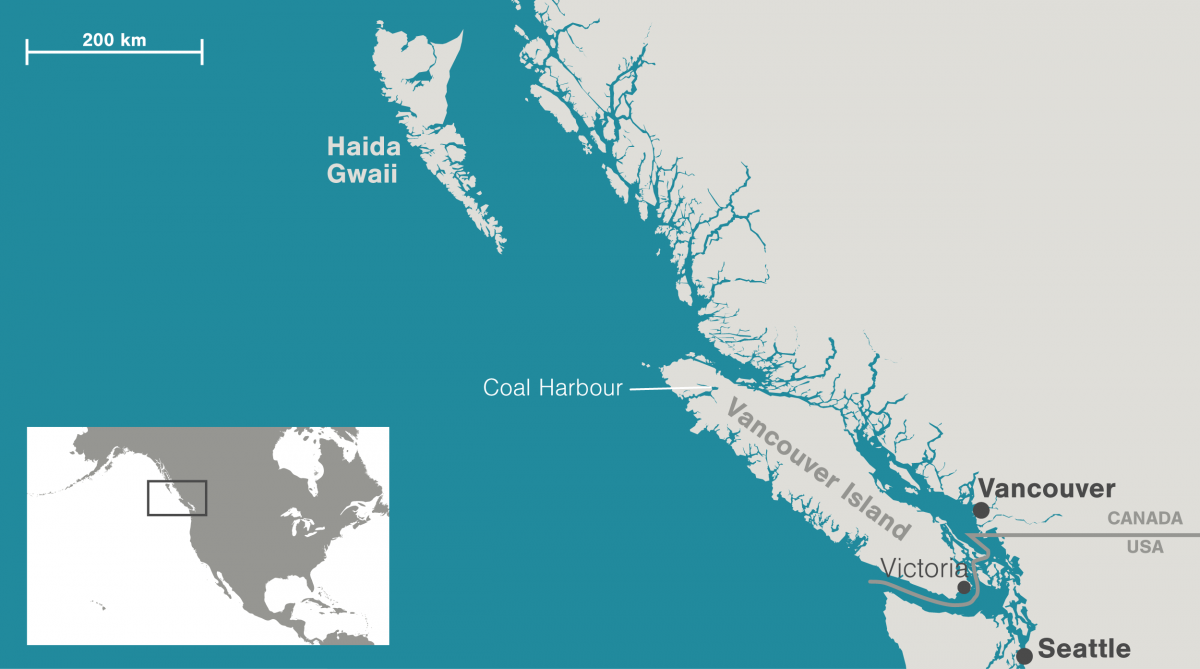
The Coal Harbour whaling station was located at the end of a long, well-protected inlet off Quatsino Sound. It gave the commercial whalers access to the west coast of Vancouver Island where they intercepted migrating whales. Map data by OpenStreetMap via ArcGIS
This slaughter came at a time when the idea of killing a whale for its meat and oil was as palatable to most people as catching a salmon for dinner. At the time, most species of whales were widely seen as being no different than any other natural resource—trees, minerals, fish—that could be harvested for the benefit of workers, the consuming public, and company shareholders.
For the Hole family, whaling was a boon: they found steady work using two of their boats to tow whale carcasses from the mouth of Quatsino Sound to the station. Young Harry spent about four years working primarily as a meat cutter at the shore station, serving occasionally on the boats that chased or towed whales.
Although whaling revived Coal Harbour, it wasn’t new in the northeast Pacific. The Nuu-chah-nulth First Nations, who lived along the island’s west coast, were renowned whalers who sustainably harvested whales for millennia. But the Pacific whaling that started in 1789 with the first passage of a whaling ship around Cape Horn was an infinitely more rapacious commercial enterprise.
By the mid-1850s, whales were being hunted from the Chukchi Sea in the western Arctic all the way down to Baja California. In these early days of Pacific whaling, commercial whalers were limited to hunting slow-swimming whales that frequented the coast, like humpbacks and Pacific right whales. Much of this whaling was ship-based and the crews would remove only the blubber before discarding the animal. Despite limited technology, they managed to deplete stocks of the whales they could access. The heyday of early whaling had nearly wiped out Pacific right and gray whales by the latter half of the 19th century, and by the 1940s humpbacks were not far behind. As these species became depleted, the future of whaling looked bleak. But technological advances soon brought the moribund industry back to life.
Foremost of these was the widespread adoption of grenade harpoons, which could reliably kill the biggest whales. At Coal Harbour’s museum, Hole points out a rusted, unarmed 1.5-meter harpoon, weighing about 60 kilograms, designed to be fired from a swivel-mounted cannon: long metal barbs on the tip spring open after entering the whale, triggering an internal explosion that embeds the head deep into the body. A single shot was usually lethal.
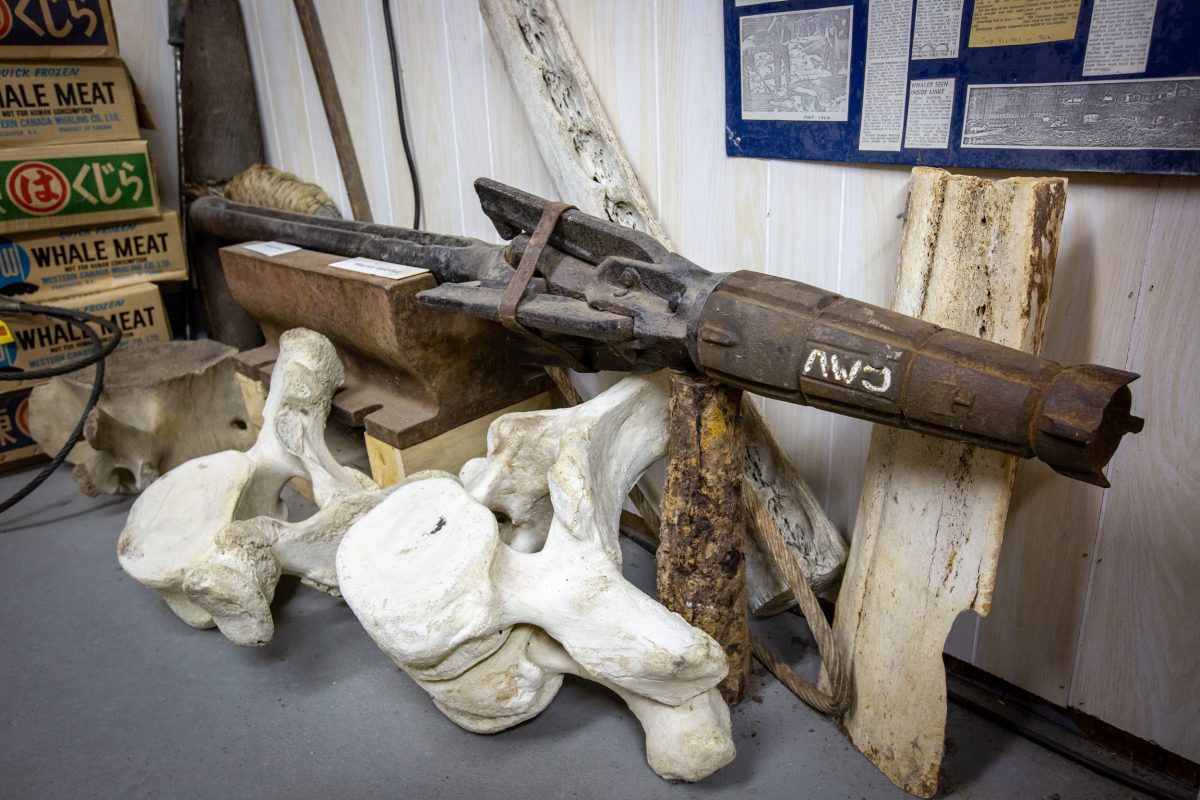
The items on display at the Coal Harbour museum, including this harpoon head, provide insight into the operation of a mid-20th century shore-based whaling station. Photo by Grant Callegari
Coal Harbour as a shore-based station was a modern industrial wonder for the time. It was designed to extract every last drop of oil and value from the whale. Once the meat for animal feed was removed, the remaining blubber, flesh, bones, and viscera were cooked in one of four digesters—giant pressure cookers capable of holding 55 tonnes each, which freed massive amounts of oil. The resulting sludge went into huge separators, and the products were then put through a variety of cooking, drying, and evaporating processes; the protein-rich liquid became dried fish stock and chicken meal, and the remaining solids went to bone meal fertilizer. The cumulative odor produced by these processes was so putrid it enveloped the village.
Between the shore station and chaser boats, there were typically about 100 seasonal workers living in Coal Harbour during whaling season through much of the station’s life, which brought the Coal Harbour population up to 150 or so. Most did not linger in the off-season, including the many Newfoundlanders who would go home.
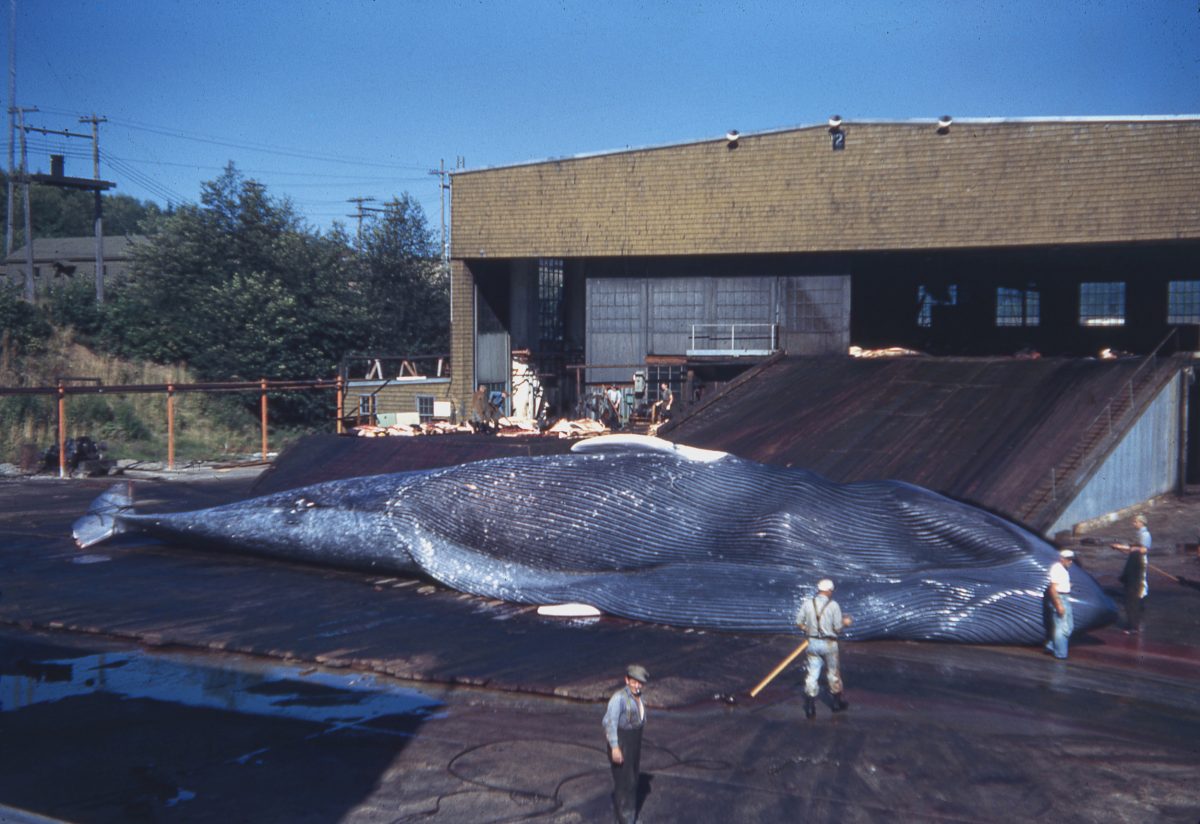
Workers at Coal Harbour’s whaling station prepare to flense a blue whale. This photo was taken sometime in the late 1950s or early 1960s. Photo by Ian MacAskie/Pacific Biological Station/DFO
It took about a dozen crew members to man a chaser boat, which in the early years included a converted minesweeper and halibut longliner. (In the 1950s, two chaser boats were brought to the station from the Antarctic.) Spotters scanned the horizon for whale spouts from the crow’s nest, as the chasers patrolled areas where past kills and sightings had taken place. Conditions on these vessels were cramped and “designed for discomfort,” as one whaler recalled, with no seating and temperatures ranging from frigid to furnace-like.
Norway, one of the world’s great whaling nations, supplied the majority of the gunners, who were the undisputed world leaders of this occupation. At Coal Harbour, the greatest was a Norwegian named Arne Borgen, a veteran gunner of Antarctic whaling who celebrated his birthday in 1963 by killing 12 sperm whales between noon and 9:00 p.m.
If the hunting was good, the ships stayed at sea for up to six days. After killing a whale, the whalers would pump it full of compressed air, flag it for pickup, and move on to the next kill. When they were done in an area, the chaser boats would gather the whales and tow them to the mouth of the sound for pickup. Sharks were known to rip half-moon-shaped bites out of the flanks of flagged dead whales as they floated at sea—crew members used .22-caliber rifles to discourage such feasting.

Harry Hole, who started working at the Coal Harbour whaling station in 1951, stands beside the jaw of a blue whale. Photo by Grant Callegari
Massive fin whales—surpassed in size only by blue whales—accounted for about a third of the 10,362 whales processed at Coal Harbour between 1948 and 1967. Over 3,000 sperm whales were taken over the same period. Far fewer blue whales were killed, but by virtue of their size, they were the biggest prize. To illustrate, Hole walks into the main hangar adjacent to the museum, now a base of operations for Eilertsen’s floatplane business. Still a tall man at 1.8 meters, Hole is dwarfed by blue whale jawbones standing five meters high.
Sperm whales were also prized, but for different reasons. The spermaceti oil found in the melon—an elongated barrel-shaped organ that takes up much of a sperm whale’s immense blockish head—was a valuable commodity. Hole remembers that the US military took regular shipments of spermaceti oil from the Coal Harbour station in the early 1950s during the Korean War—they were just one of many industrial customers who relied on its heat- and pressure-resistant properties.
From the intestines of sperm whales sometimes came ambergris—solid deposits formed around undigested squid and cuttlefish beaks—which contained ambrein, an odorless alcohol historically used to give perfume a longer-lasting scent. It was exceedingly rare, says Hole. He remembers when a single whale brought into the station yielded 315 kilograms of ambergris, worth a small fortune at the time.
Hole brings out a series of small glass jars containing different grades of whale oil, which were used to make everything from margarine to shoe polish. But in spite of the many uses for the oil, the Western Whaling Company was at the mercy of volatile commodity prices and competition from other raw materials. In the late 1940s, a worldwide glut of vegetable oil forced the company to store its oil until prices increased. Almost a decade later, the 1959 catch was strong with 869 whales killed, including 28 blue whales, but profits were miniscule. Whale meat had recently lost almost half of its value, while sperm oil dropped to its lowest price since the Second World War.
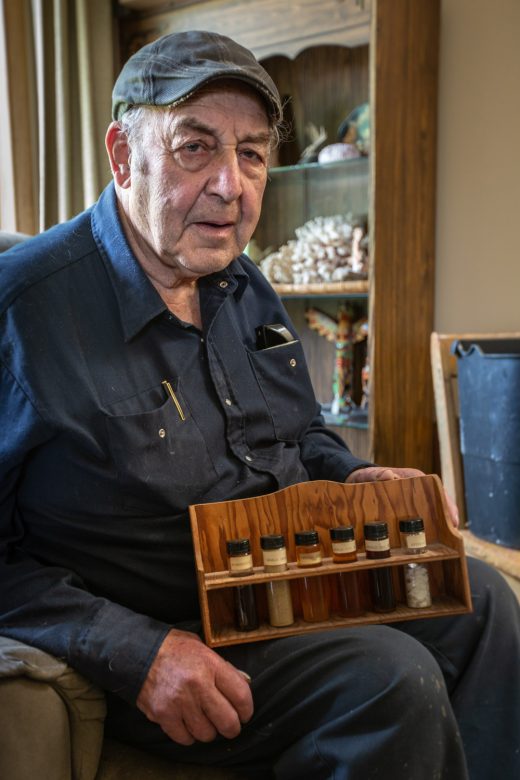
Harry Hole with a display of the various products that came out of the Coal Harbour whaling station, including ambergris, whale meal, and sperm whale oil. Photo by Grant Callegari
A year later, declaring the market for whale products untenable, the Coal Harbour whaling station closed. As Hole remembers, whale oil was increasingly being replaced by high-quality and less expensive oils derived from plants and petroleum.
Coal Harbour would have stayed shuttered if it wasn’t for the Japanese appetite for whale meat. In 1960, British Columbia Packers, part of the original consortium and by then the sole owner, forged a new partnership with Taiyo Gyogyo Kabushiki Kaisha, one of Japan’s biggest whaling and fishing businesses. With an influx of Japanese money and expertise, Coal Harbour was back in business, this time supplying fresh-frozen whale meat for the Japanese food market.
The partnership brought more than a dozen unilingual Japanese workers to Coal Harbour. At this point, Japanese Second World War aggression—including at least one explosive aerial balloon that landed close to the village but failed to explode—was very recent history. Yet the hostilities of the past were not an issue among workers by the early 1960s, says Hole.
The appearance of the Japanese provided a lifeline for the company and workers, but new troubles soon appeared on the western horizon. In July 1963, a Coal Harbour chaser boat met a Soviet factory whaling fleet just west of the southernmost tip of Haida Gwaii, approximately 200 kilometers northwest of Coal Harbour, where the two competed for the same blue whale.
Pelagic factory fleets were the next iteration of global whaling technology and they cut out the need for shore-based stations like Coal Harbour. Fleets were comprised of a factory mother ship and several catcher, scouting, and supply vessels, which meant they could fully process the whales at sea. Led by the Russians and Japanese, these factory fleets chased whales to the most remote corners of the planet, impervious to regulation and international law.
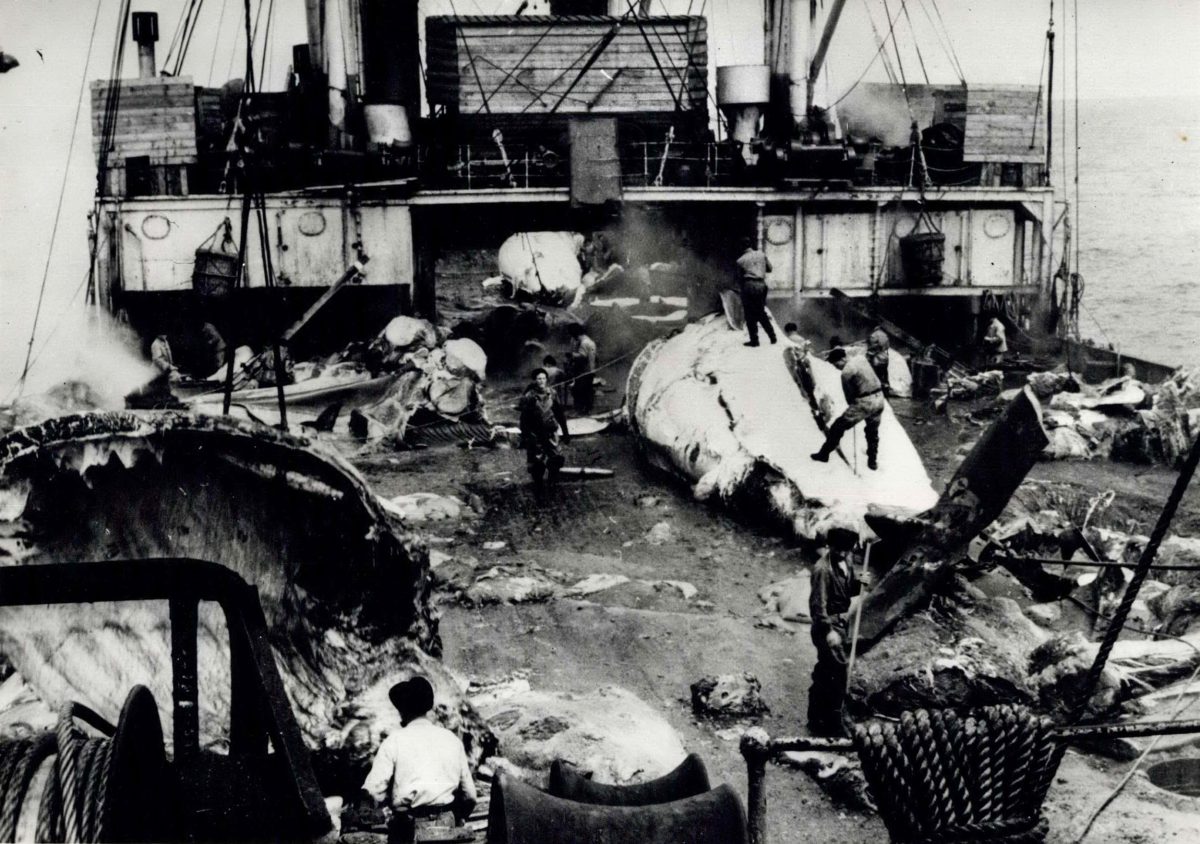
In the 1950s, factory whaling fleets, with several chaser boats and the ability to process whales at sea, soon began to replace shore-based whaling stations. This image is of a Russian factory ship. Photo by Keystone Press/Alamy Stock Photo
The same year as the encounter off Haida Gwaii, seven Soviet factory fleets were hunting whales around the world. The single biggest Russian fleet, active in the Antarctic, employed 25 high-speed catcher boats. In the North Pacific alone, the Russians killed almost 200,000 whales between 1947 and 1979, many of them illegally.
Against the deadly efficiency of this factory fleet onslaught, tiny Coal Harbour, let alone the whales, had no hope for survival.
By the early 1960s, there were just four shore-based whaling stations left on the Pacific coast of North America—Coal Harbour; two inside San Francisco Bay at Richmond, California; and one at the mouth of the Columbia River in Oregon. With most whale products replaced by synthetic alternatives, the remaining US stations mostly supplied meat for pet food. Coal Harbour alone was producing food for human consumption.
Ken Balcomb was 24 when the US government hired him to inspect whale carcasses at the two San Francisco Bay stations in 1964.
“They were big, bloody butcher factories,” recalls Balcomb, who went on to become a US Navy pilot and later a preeminent killer whale researcher who founded the Center for Whale Research in 1985. Despite the gore, the stations offered a unique opportunity for the recent university zoology grad with a keen interest in anatomy; he took measurements and collected samples of ovaries, testes, and other body parts for analysis at government labs.
The world would soon change for Balcomb and a generation of pioneering whale researchers when they realized it was possible to identify individual whales using photography, meaning they could study them alive in the ocean over time.
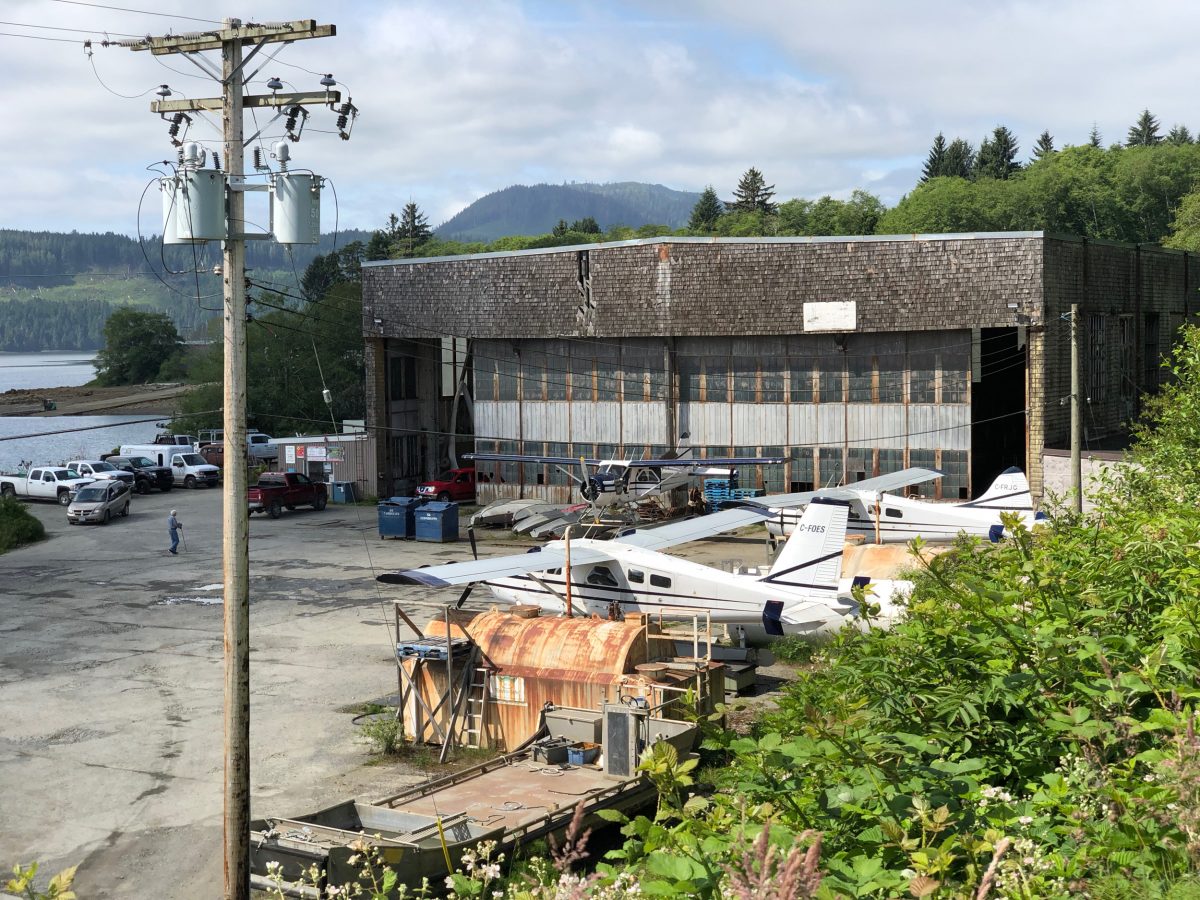
Buildings constructed during the Second World War, such as this hangar, provided much-needed infrastructure for Coal Harbour’s whaling station, which started operations just a few years after the war ended. Today the hangar is the base for a floatplane business, right next door to the town’s museum. Photo by Grant Callegari
Led by Canadian federal government biologist Michael Bigg, Balcomb, and others, the practice of photo IDing whales in the wild ultimately made it possible to calculate population estimates, map migration patterns, and better understand the language, society, and culture of killer whales. (Photo ID techniques are now used on several marine mammal species.) As the environmental and animal rights movements gained momentum in the late 1960s and early 1970s, these revelations into the complex lives and relationships of whales made it clear that killing a whale was not the same as killing a fish.
By 1965, the big blue, fin, and sperm whales that Coal Harbour relied on were becoming hard to find. The relatively small sei whales were now accounting for 70 percent of the annual harvest. That year, the IWC imposed a one-year ban on killing humpbacks in the North Pacific and a five-year ban on blues.
Within two years, amid depressed meat markets and depleted whale populations, Coal Harbour closed for good.
To this day, Hole maintains that Coal Harbour closed because of IWC regulations and overharvesting by Russian and Japanese factory ships active in the North Pacific. But there’s little doubt that shore-based stations also played a part. Between 1954 and 1960, for instance, Balcomb says shore-based whalers wiped out all the humpbacks on the central California coast.
In 1968, a year after Coal Harbour closed, Balcomb, who had always been fascinated by what he heard about the whaling station at the tip of Vancouver Island, traveled there for a visit. He remembers the stench of dead whale and the close camaraderie he shared with former workers who lingered there.
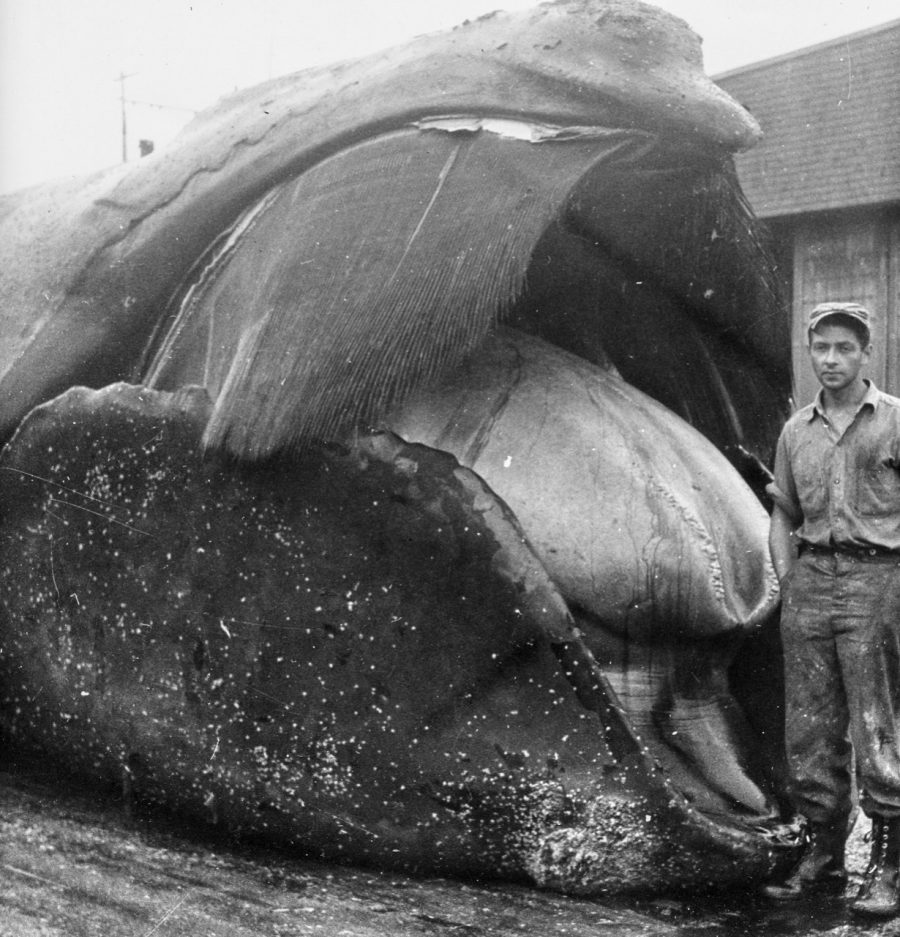
Shore-based whaling stations provided one of the few ways that biologists could gather data about whales. Here, Gordon Pike, a biologist then with the Department of Fisheries and Oceans, stands with a North Pacific right whale at Coal Harbour in 1951. This was the last right whale seen in British Columbia waters until 2013. Photo by Gordon Pike/Pacific Biological Station/DFO
Balcomb never met Hole, but 50 years later, he doesn’t think the working men of that generation should be judged too harshly for their part in whaling.
“You shouldn’t vilify them,” he says of the rank-and-file workers. “It was a business just like logging was a business or like the fishing industry now. It was also overexploiting the natural resources. Our politicians are doing the same thing to the ecosystem right now.”
In the summer of 2018, Harry Hole got another chance to hunt for whales. This time, he took his grandson to nearby Telegraph Cove, on the island’s east coast, where they saw killer whales and humpbacks during a whale watching tour.
Hole reddens as he recalls the experience. He admits his attention was drawn by things the other passengers could not conceive—like the angle of the boat as it approached the humpbacks, a critical consideration for the gunners on Coal Harbour chaser boats.
As for the killer whales, Hole has no working knowledge of these recent tourist favorites, given that they were historically considered pests and too small to be valuable. With one notable exception.
“The only killer whale that was ever brought in here was shot for Walt Disney in the late 1950s,” he says. “We took the guts out of it, filled it full of formaldehyde and salt, and shipped it on the deck of a boat to San Francisco.”
The world has changed a lot since the late 1950s when the Disney special order was filled, but some things remain the same.
From his perch in the museum, Hole doesn’t flinch at the mention of Japan’s return to the commercial hunt—the first two whales will be killed weeks after my visit. By early October, Japanese whalers ended their 2019 season with 256 minke, Bryde’s, and sei whales killed, all within Japan’s territorial waters.
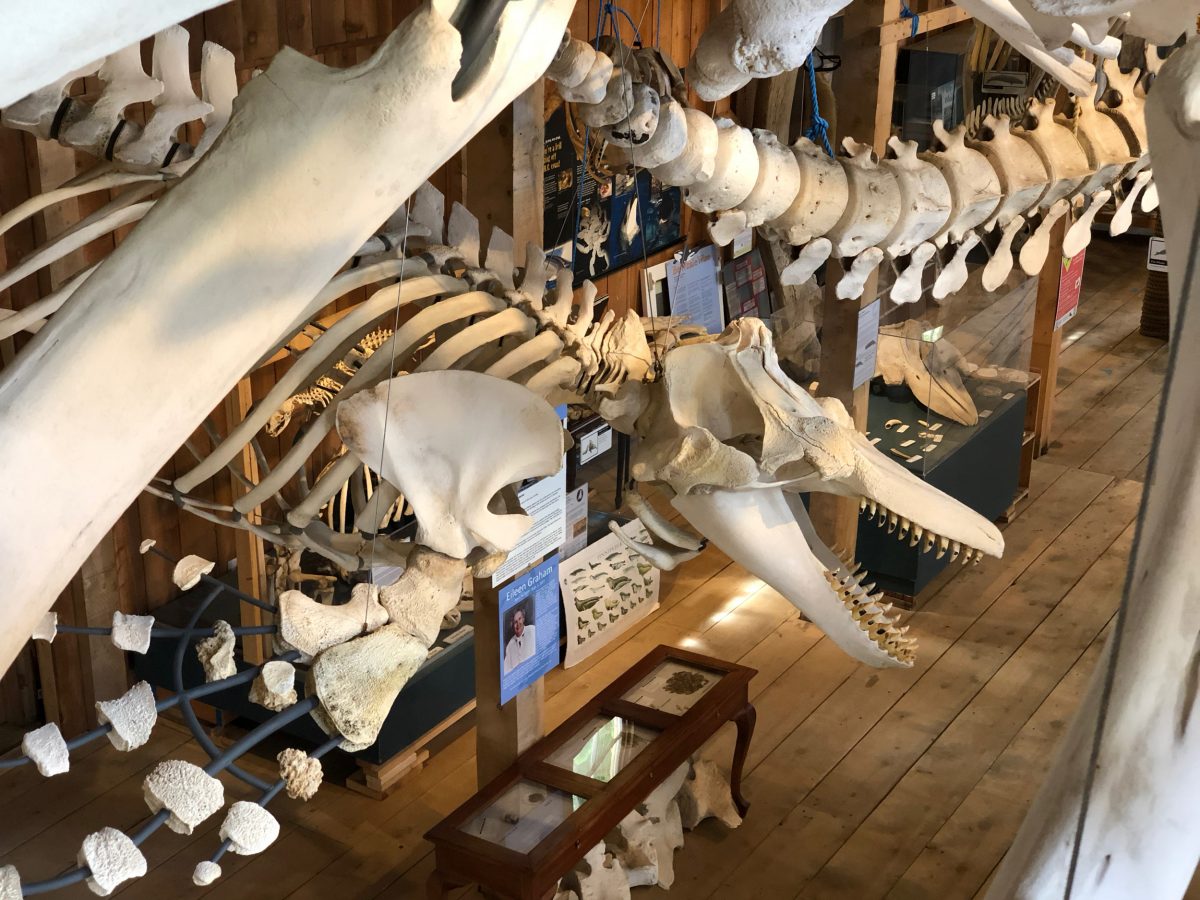
The Whale Interpretive Centre at Telegraph Cove, British Columbia, provides visitors with information on whale biology and ecology. Whale watching expeditions from the area give opportunities to see killer whales, humpback whales, other marine mammals, and seabirds. Photo by Grant Callegari
It’s a non-story, says Hole: countries including Iceland, Norway, and Japan have never stopped whaling, regardless of what North Americans think about the ethics of killing whales.
If the hunt can be done without diminishing populations deemed to be healthy, as the Japanese maintain, Hole thinks a harvest makes perfect sense. “I don’t see anything wrong with it, really,” he says. “I’m with the Japanese.”
Outside the museum, a floatplane is taking off, loaded with supplies for a distant logging camp. With a current population of about 170, the demise of commercial whaling here did not portend the death of Coal Harbour. It survives now as a bedroom community for the nearby town of Port Hardy with the help of Eilertsen’s floatplane base and harbor enterprise, a wharf and boat launch, and the Hole family water taxi business, now operated by Harry’s son Lionel.
Coal Harbour is hanging on and at least some of the whales seem to be, too. Humpbacks are on the rebound in the area: 30 years ago, it was rare to see a single humpback in Johnstone Strait off Telegraph Cove, but now it’s possible to see 10 during a single whale watching trip.
The great fin whales appear to be on the upswing too, with approximately 400 animals estimated to seasonally inhabit the very waters where Coal Harbour chaser boats once hunted them.
The same cannot be said for the sperm, blue, and sei whales. Despite a sea change in the way most of us value whales, they are now rarities on this coast.
Plundered and now locally revered in absentia, their recovery is an open question.

